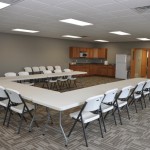
Flagman Larry Cook, right, joins Alta promoter, the late Dick Simpson and driver Denny Hovinga in victory lane.
Larry Cook was born into a racing family and seemingly was ordained from the start to become involved in the sport. Cook’s father Chet was a racer and car owner in his day. His uncle Dwight Cook was also heavily involved in the sport as a flagman and track promoter of the Kossuth County track.
Larry’s first involvement in the sport of racing was behind the wheel. In the early 1960’s his wife Kay worked for Dutch Honsbruch at Honsbruch Drug. One day she mentioned to Honsbruch that Larry liked racing. Soon after, Honsbruch, Cook and Gene Schattschneider collaborated on building a race car. Honsbruch helped provide the funding, Schattschneider used his mechanical ability to help build the car and Cook was slated to be the driver.
The trio’s first race was in 1961 on the half mile track in Algona. Cook’s first time behind the wheel, would prove to be his only time, however. In that first race, competitor Larry Cordes crashed in the fourth turn sending his car over the wall. When Cordes’ car came to a rest it burst into flames with the driver trapped inside. Cook and others rushed to aid Cordes; however, since the car landed outside the track, it was difficult to get the driver extracted in time.
 The experience caused Cook to take a step back and decide that driving the race car was not worth the potential risks involved. Sometime later, Algona track promoter Lamont Wellendorf asked Cook to be the flagman. This began a long career as a track official that lasted until 1982.
The experience caused Cook to take a step back and decide that driving the race car was not worth the potential risks involved. Sometime later, Algona track promoter Lamont Wellendorf asked Cook to be the flagman. This began a long career as a track official that lasted until 1982.
It turned out to be a true family affair as Cook would flag the races, his wife worked in the concession stand and his children sold the National Hawkeye Racing News in the grandstand. Cook’s career as a flagman grew as was soon flagging events four to five nights a week. During his career he flagged at tracks in Algona, Alta, Harlan, Denison, Rock Rapids and Fairmont.
He counts his favorite memories as all the friends he made in the sport and having the opportunity to work for great promoters like Wellendorf and Dick Simpson. Other favorite memories included flagging events in the Midwest that drivers like A.J. Foyt and Johnny Rutherford competed in. He also considered Gene Schattschneider and Les Wildin as friends.
Being a flagman at a short track can also pose some challenges at times. He recalls a night at Algona in which Bruce Sommerfeld was so mad at Cook for black flagging him; the driver brought a five gallon pail of water to the front stretch to douse Cook.
 The hardest night for Cook as a flagman occurred in 1976 when he was run over on the track by a driver and was thrown nearly 150 feet. Cook recovered; however, he says he was quite grateful that shortly after that tracks started putting the flag stand in the grandstands.
The hardest night for Cook as a flagman occurred in 1976 when he was run over on the track by a driver and was thrown nearly 150 feet. Cook recovered; however, he says he was quite grateful that shortly after that tracks started putting the flag stand in the grandstands.
Cook left the flag stand for the final time in 1982. Cook then moved to Des Moines, Iowa in 1985 to manage a location there for VanderHaag’s.
Today, Cook is retired and he and his wife Kay split their time between homes in Arnolds Park, Iowa and in Arizona. They will be celebrating 50 years together in February 2010.
